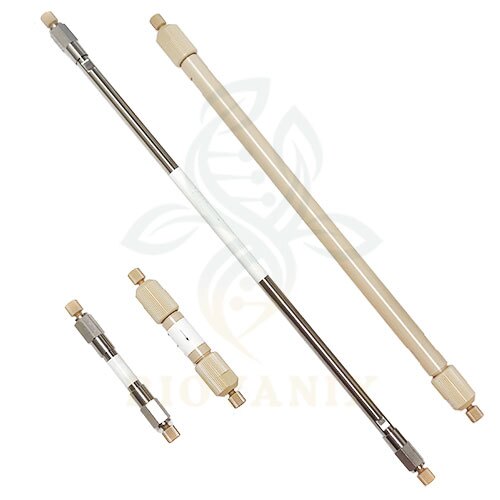The Selection of HPLC Column By USP
USP (United States Pharmacopeia) columns are high-performance liquid chromatography (HPLC) columns designed to meet the stringent standards set by the USP, ensuring consistency, reliability, and compliance in analytical procedures. These columns are widely used in pharmaceutical, environmental, and food safety applications to provide accurate and reproducible results.

Key Feature of USP Column
- Standardized Classification: USP columns are categorized based on their stationary phase characteristics, each assigned a specific “L” number. This classification helps users quickly identify the appropriate column for their specific analytical needs.
- Wide Range of Applications: USP columns cover a broad range of chemistries, including C18 (L1), C8 (L7), NH₂ (L8), CN (L10), and many others. These columns are suitable for analyzing a variety of compounds, from small molecules to complex mixtures.
- High Quality and Compliance: Each USP column is manufactured to meet the exact specifications outlined by the USP, ensuring high performance and reliability in regulated environments.
- Versatile Options: Available in various particle sizes and formats (e.g., fully porous, fused-core, monolithic), USP columns can be tailored to meet diverse analytical requirements.
Application of USP Column
- Pharmaceutical Analysis: USP columns are extensively used in the pharmaceutical industry for the separation and quantification of active pharmaceutical ingredients (APIs), impurities, and degradation products. For example, L1 (C18) columns are commonly used for reversed-phase HPLC analysis.
- Environmental Monitoring: These columns are employed to detect and quantify pollutants and contaminants in water and soil samples. Specific chemistries like CN (L10) and NH₂ (L8) are useful for analyzing polar compounds.
- Food Safety: USP columns help in the analysis of food additives, contaminants, and nutritional components, ensuring compliance with food safety regulations
| USP Listing | Description | Products |
| L1 | Octadecyl silane chemically bonded to porous or non-porous silica or ceramic microparticles, 1.5 to 10 µm in diameter, or a monolithic rod | C18/ODS |
| L3 | Porous silica particles, 1.5 to 10 µm in diameter, or a monolithic silica rod | Silica |
| L7 | Octylsilane chemically bonded to totally or superficially porous silica particles, 1.5 to 10 µm in diameter, or a monolithic silica rod | C8 |
| L8 | An essentially monomolecular layer of aminopropylsilane chemically bonded to totally porous silica gel support, 1.5 to 10 µm in diameter, or a monolithic silica rod | NH2 |
| L9 | Irregular or spherical, totally porous silica gel having a chemically bonded, strongly acidic cation-exchange coating, 3 to 10 μm in diameter | SCX |
| L10 | Nitrile groups chemically bonded to porous silica particles, 1.5 to 10 µm in diameter, or a monolithic silica rod | CN |
| L11 | Phenyl groups chemically bonded to porous silica particles, 1.5 to 10 µm in diameter, or a monolithic silica rod | Phenyl |
| L14 | Silica gel having a chemically bonded strongly basic quaternary ammonium anion-exchange coating, 5 to 10 µm in diameter | SAX |
| L17 | Strong cation-exchange resin consisting of sulfonated cross-linked styrene-divinylbenzene copolymer in the hydrogen form, 6 to 12 µm in diameter | Sugar-10H |
| L19 | Strong cation-exchange resin consisting of sulfonated cross-linked styrene-divinylbenzene copolymer in the calcium form, 5 – 15 µm in diameter | Sugar-10Ca |
| L20 | Dihydroxypropane groups chemically bonded to porous silica or hybrid particles, 1.5 to 10 µm in diameter, or a monolithic silica rod | HILIC-Diol SEC |
| L26 | Butyl silane chemically bonded to totally porous or superficially porous silica particles, 1.5 to 10 µm in diameter | C4 |
| L40 | Cellulose tris-3,5-dimethylphenylcarbamate coated porous silica particles, 3 µm to 20 µm in diameter | Chiral OD |
| L43 | Pentafluorophenyl groups chemically bonded to silica particles by a propyl spacer, 1.5 to 10 µm in diameter | PFP |
| L51 | Amylose tris-3,5-dimethylphenylcarbamate-coated, porous, spherical, silica particles, 3 to 10 µm in diameter | Chiral AD |
| L58 | Strong cation-exchange resin consisting of sulfonated cross-linked styrene-divinylbenzene copolymer in the sodium form, about 6 to 30 µm diameter | Sugar-10Na |
| L60 | Spherical, porous silica gel, 10 µm or less in diameter, the surface of which has been covalently modified with alkyl amide groups and endcapped | Polar C18 |
| L62 | C30 silane bonded phase on a fully porous spherical silica, 3 to 15 µm in diameter | C30 |
| L68 | Spherical, porous silica, 10 µm or less in diameter, the surface of which has been covalently modified with alkyl amide groups and not endcapped | HILIC-Amide Glycan |
| L78 | A silane ligand that consists of both reversed-phase (an alkyl chain longer than C8) and anion-exchange (primary, secondary, tertiary, or quartenary amino groups) functional groups chemically bonded to porous or non-porous silica or ceramic micro-particles, 1.0 to 50 μm in diameter, or a monolithic rod | SAA |
| L80 | Cellulose tris(4-methylbenzoate)-coated, porous, spherical, silica particles, 5 – 20 µm in diameter | Chiral OJ |
| L90 | Amylose tris-[(S)-alpha-methylbenzylcarbamate] coated on porous, spherical silica particles, 3 to 10 µm in diameter | Chiral AS |
| L118 | Aqueous polymerized C18 groups on silica particles, 1.2 to 5 μm in diameter | PAH |

